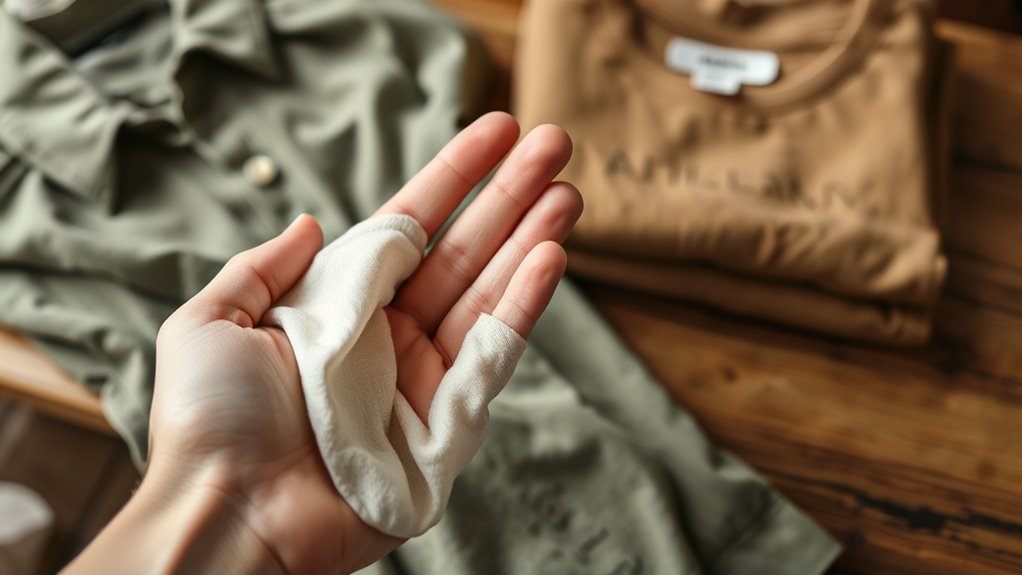When looking for ethical and sustainable fashion, focus on brands that use eco-friendly fabrics like organic cotton, recycled fibers, or natural dyes. Check labels for certifications such as GOTS or Fair Trade and look for transparent supply chain information. Prioritize garments designed for durability to reduce waste and support companies committed to fair labor practices. Supporting local artisans and making informed care choices also make a difference. Keep exploring to discover more ways to shop responsibly.
Key Takeaways
- Look for trusted certifications like GOTS, Fair Trade, or Vegan Society that verify environmental and ethical standards.
- Choose brands that transparently share sourcing, production processes, and supply chain audits.
- Prioritize garments made from natural, recycled, or eco-friendly materials with minimal chemical dyes.
- Support small-scale and local producers committed to ethical labor practices and traditional craftsmanship.
- Opt for durable, high-quality clothing to maximize longevity and reduce environmental impact over time.
Recognizing Eco-Friendly Fabrics and Materials

Have you ever wondered how to identify truly eco-friendly fabrics? One key indicator is the use of natural dyes, which come from plants, minerals, or insects, avoiding harmful chemicals. These dyes not only reduce environmental impact but also add unique color variations. Additionally, look for fabrics made from recycled fibers—such as recycled polyester or nylon—that repurpose waste materials instead of virgin resources. Recycled fibers help lower pollution and conserve water and energy during production. When shopping, check labels or ask brands about their sourcing methods. Fabrics created with natural dyes and recycled fibers demonstrate a commitment to sustainability. Recognizing these materials allows you to support eco-friendly practices and make more conscious choices in fashion. Natural dyeing processes play a significant role in promoting environmentally responsible fashion choices.
Understanding Certification Labels and Standards
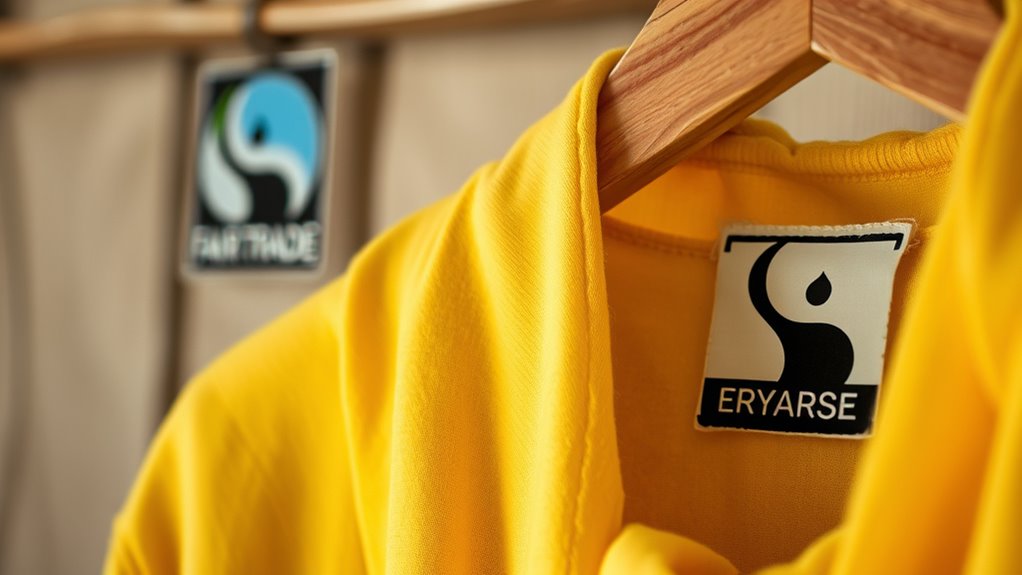
You need to know how to spot trusted certifications on clothing labels to guarantee they meet ethical standards. Learning to interpret label standards helps you make informed choices and avoid greenwashing. Once you understand these labels, it becomes easier to support genuinely sustainable fashion brands. Recognizing certification labels that are backed by reputable organizations ensures your purchases align with your values.
Recognizing Trusted Certifications
Understanding certification labels and standards is essential for making informed choices in ethical and sustainable fashion. Trusted certifications help you identify brands committed to responsible practices, like textile recycling and using vegan materials. Look for labels such as GOTS for organic textiles, Fair Trade for fair labor, and the Vegan Society stamp. These certifications guarantee the product meets strict environmental and ethical criteria. By recognizing genuine labels, you avoid greenwashing and support brands that prioritize sustainability. Keep an eye out for certifications that verify eco-friendly processes and social responsibility. Recognizing narcissistic traits in marketing and branding can also help you avoid misleading claims and ensure your purchases align with your values. Being informed helps you make confident choices, ensuring your fashion choices contribute to a more sustainable industry.
Interpreting Label Standards
Interpreting label standards is key to verifying that a product truly meets its ethical and sustainability claims. Pay close attention to the label language; clear, specific terms like “fair trade” or “organic” indicate genuine standards. Be mindful of where the tags are placed—labels sewn inside or on the back are less likely to be altered than stickers or tags in obvious spots. Look for certifications listed directly on the label, not just on packaging. Remember, some brands use vague or misleading language to appear sustainable. By understanding how to interpret these labels and their placement, you can better distinguish authentic eco-friendly products from those that are simply marketing. Your awareness ensures you support truly ethical fashion choices. Recognizing the label placement can also help determine the authenticity of the claims.
Evaluating Supply Chain Transparency
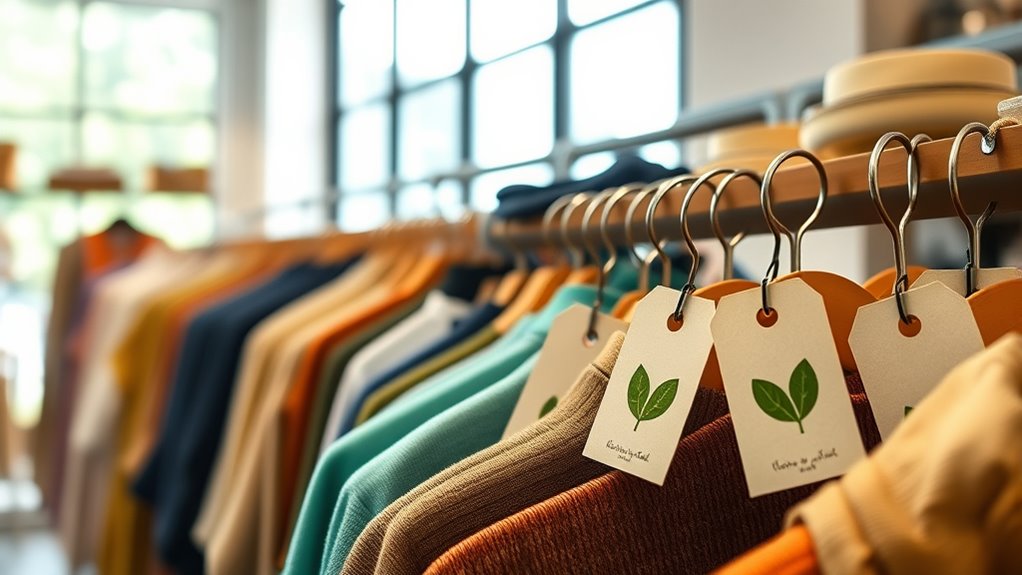
Evaluating supply chain transparency is essential for ensuring that fashion brands uphold ethical and sustainable practices. You want to verify that companies are genuinely committed to supply chain ethics and transparency initiatives. Look for brands that openly share details about their sourcing, manufacturing processes, and supplier audits. Transparency helps you see if fair labor practices are followed and if environmental standards are maintained throughout the supply chain. Additionally, understanding the top beach towns on the East Coast can inspire eco-friendly travel choices that align with your values. To assess transparency effectively, consider these points:
- Check for detailed sourcing maps or supplier lists on their website
- Look for third-party certifications verifying ethical standards
- Review their public reports on supply chain practices
- Investigate any reports of supply chain issues or controversies
This approach guarantees your choices support truly responsible fashion.
Assessing Fair Labor and Worker Conditions
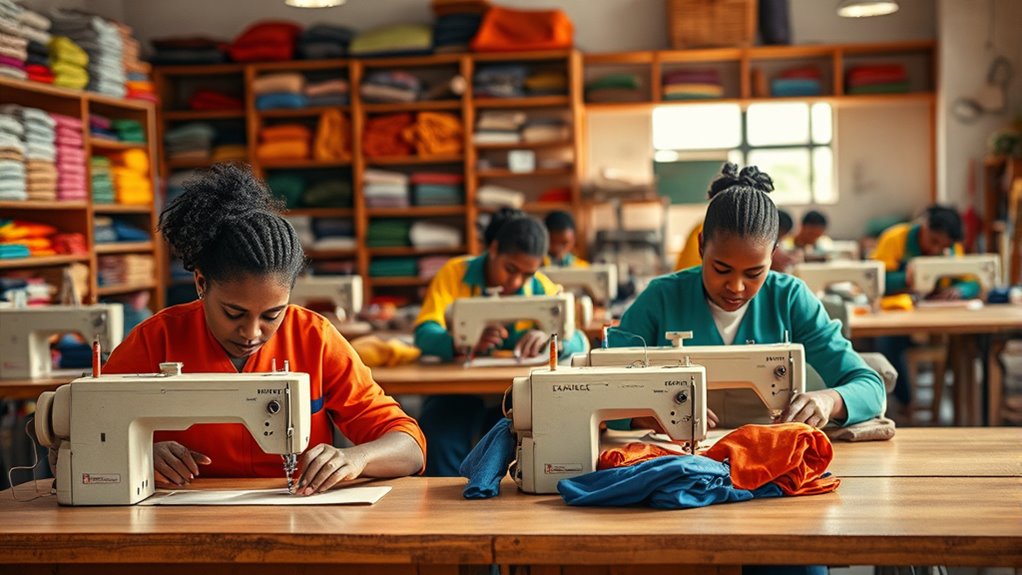
You need to guarantee factory safety standards are met so workers aren’t put at risk. Verify that fair wage policies are in place, allowing employees to support themselves and their families. Additionally, check that worker rights are enforced to prevent exploitation and promote dignity on the job. Cultivating awareness of creative practice principles can also foster innovative solutions for improving working conditions.
Factory Safety Standards
How do we guarantee that factories meet essential safety standards and treat workers fairly? Ensuring factory safety involves checking for proper measures that reduce workplace hazards and protect workers from injury. You should look for brands that prioritize safe working conditions and regularly inspect factories. Certification labels like OHSAS 18001 or SA8000 can signal compliance with safety standards. It’s important to ask about emergency protocols, fire exits, and protective equipment. Implementing systematic testing methodologies can help verify that safety procedures are effectively in place and followed. Key factors to consider include: – Regular safety audits and transparent reporting – Proper training on workplace hazards – Adequate safety gear and emergency preparedness – Enforcement of safety policies and worker rights
Fair Wage Policies
Ensuring factory safety is only part of creating ethical fashion; fair wages are equally important in supporting workers’ well-being. When evaluating brands, look for signs of wage transparency and fair compensation. Companies committed to fair wage policies openly share wage information and ensure workers earn enough for a decent life. Fair wages help reduce exploitation and foster a more sustainable fashion industry. Wage Transparency builds trust and accountability, ensuring that workers are paid fairly for their labor.
Worker Rights Enforcement
Are factory inspections and monitoring effective ways to guarantee fair labor practices? They’re essential, but not enough on their own. To truly enforce worker rights, you need transparent reporting and independent audits that hold brands accountable. Ensuring worker safety involves more than just inspections; it requires ongoing dialogue and community engagement. Look for brands that:
- Regularly publish audit results and corrective actions
- Support worker participation in safety committees
- Guarantee fair treatment and zero retaliation
- Promote transparent supply chain traceability
These measures help protect labor rights and improve working conditions. When brands prioritize proactive enforcement, they demonstrate a genuine commitment to ethical standards. Remember, sustainable fashion isn’t just about materials—it’s about respecting the people behind every stitch. Incorporating appetizer tasting principles can inspire innovative and ethical approaches within the fashion industry.
Considering the Longevity and Durability of Garments
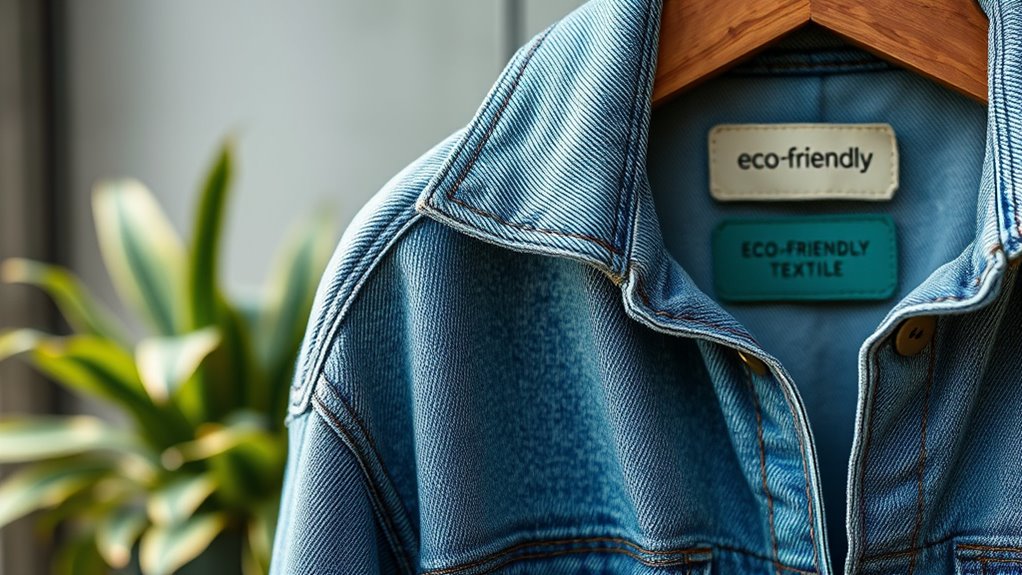
When you choose garments with greater longevity and durability, you’re making a conscious step toward ethical and sustainable fashion. These pieces typically have a longer garment lifespan, meaning they won’t need replacing as often, reducing waste. Focus on wear resistance, which indicates how well a fabric withstands daily use without tearing or fading. High-quality materials like heavy-duty denim or tightly woven fabrics tend to last longer. Check stitching and construction, as strong seams prevent early damage. Investing in durable garments may cost more initially, but it pays off over time by maintaining their appearance and function longer. By prioritizing longevity and wear resistance, you help minimize fast fashion’s environmental impact and promote more thoughtful consumption.
Analyzing Brands’ Environmental Impact Initiatives

Evaluating how brands implement environmental initiatives helps you understand their commitment to sustainable fashion beyond just choosing durable garments. Look for brands that actively embrace textile recycling to reduce waste and conserve resources. Assess their investment in fashion innovation, such as using eco-friendly dyes or sustainable materials. Transparency is key—check if they share measurable goals or progress reports. Consider initiatives like reducing water consumption or minimizing carbon footprints. Brands committed to environmental impact often participate in circular economy practices, extending the lifespan of textiles. By analyzing these efforts, you can support companies genuinely dedicated to sustainability. Incorporating proper storage methods for textiles and materials also demonstrates a brand’s dedication to longevity and responsible resource use.
Supporting Local and Small-Scale Producers
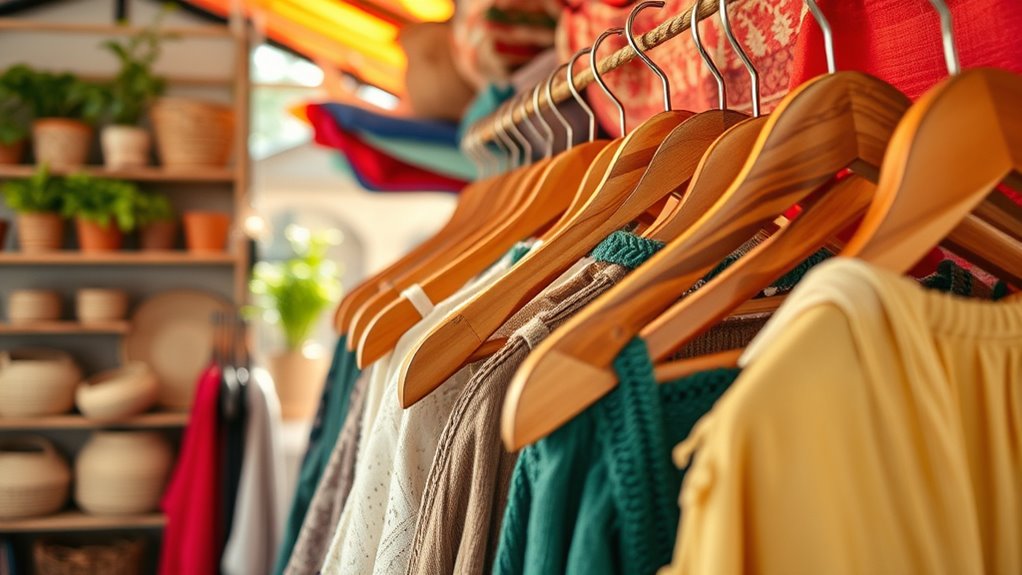
Supporting local and small-scale producers plays a crucial role in fostering ethical and sustainable fashion. When you buy from local artisans and small-scale producers, you directly support their livelihoods and help preserve traditional craftsmanship. These producers often prioritize eco-friendly materials and ethical labor practices, reducing environmental impact and ensuring fair wages. By choosing their products, you contribute to local economies and promote transparency in supply chains. Small-scale producers typically have a closer relationship with their communities, which encourages sustainable resource use and minimizes waste. Supporting them helps create a more equitable fashion industry, where quality and ethics take precedence over mass production. Your conscious choices empower local artisans and small-scale producers to thrive while advancing sustainable fashion principles.
Making Informed Purchasing Decisions and Care Practices

How can you make smarter choices when purchasing fashion items and caring for them? Start by researching brands’ commitments to fashion industry ethics and sustainable fashion activism. Look for transparency about sourcing, production processes, and labor practices. When caring for your clothes, follow eco-friendly washing and drying methods to extend their lifespan and reduce environmental impact.
Research brands’ ethics and sustainability, and use eco-friendly care practices to make smarter fashion choices.
- Choose quality over quantity to support long-lasting fashion
- Support brands that prioritize ethical labor standards
- Wash clothes in cold water and avoid dry cleaning when possible
- Repair or repurpose garments instead of discarding them
Frequently Asked Questions
How Can Consumers Verify the Authenticity of Sustainability Claims?
To verify sustainability claims, you should look for credible indicators like authenticity of sustainability certifications and transparency reports from brands. Check if the certifications, such as GOTS or Fair Trade, are recognized and verified by third parties. Review transparency reports to see how openly brands share their supply chain practices. Asking questions directly to brands and researching third-party audits helps you guarantee their claims are genuine and trustworthy.
What Are the Hidden Environmental Impacts of Fast Fashion?
Fast fashion’s hidden environmental impacts include significant environmental pollution from toxic dyes and chemicals released during production. You might not realize how much water consumption it involves, with billions of gallons used for fabric dyeing and finishing. These processes often harm ecosystems and drain water resources, contributing to environmental degradation. As a consumer, understanding these impacts helps you make more conscious choices and support brands that prioritize sustainability.
How Do Cultural and Ethical Considerations Influence Sustainable Fashion Choices?
Did you know that 66% of consumers consider a brand’s cultural symbolism and ethical sourcing when making choices? Your decisions are influenced by these factors, as they reflect respect for traditions and fair labor practices. By prioritizing brands that honor cultural significance and guarantee ethical sourcing, you support sustainability and cultural integrity. Your choices can promote fair treatment and preserve cultural identities in the fashion industry.
Can Secondhand Shopping Be a Truly Sustainable Option?
You might wonder if secondhand shopping is truly sustainable. It definitely supports the circular economy by giving vintage treasures a new life, reducing waste, and lessening demand for new resources. When you buy pre-loved clothes, you help keep items in use longer, which minimizes environmental impact. While not perfect, secondhand shopping generally promotes sustainability, especially when you choose quality pieces that last and resist fast fashion’s throwaway culture.
What Role Do Consumers Play in Promoting Ethical Fashion Practices?
You play a crucial role in promoting ethical fashion practices through consumer activism and choosing brands that prioritize ethical labeling. When you support companies committed to fair labor and eco-friendly materials, you encourage industry-wide change. Your purchasing decisions send a message that sustainability matters, motivating brands to improve transparency and accountability. By staying informed and advocating for ethical standards, you help create a more responsible and sustainable fashion industry.
Conclusion
By choosing eco-friendly fabrics, supporting transparent brands, and caring for your garments, you become part of a sustainable fashion movement. Think of your wardrobe as a garden—you nurture it with mindful choices, and it blooms with longevity and positive impact. Remember, every small step counts; just like a single seed grows into a mighty tree, your conscious decisions can transform the fashion industry into a greener, fairer space for all.
